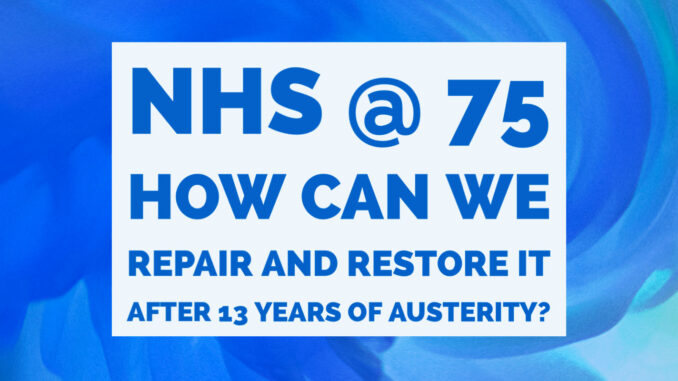

John Puntis Co-Chair of KONP spoke at ‘Arise – a festival of left ideas’ on 7 June 2023
It is obvious to most of us if not to the Government that the NHS is in crisis and I want to consider why technology, use of the private sector and reliance on prevention are not the answer to the current pressing problems such as GP access, huge waiting lists and massive staff vacancies.
Expand the workforce alongside funds to deliver
Key priorities have to be a detailed workforce plan and a huge boost in funding to match comparable European countries and to make up the accumulated deficit from 13 years of austerity. The Labour Party needs to present its own coherent plans for a capital renewal programme and funding to meet long-term needs most economically, not based around self-imposed fiscal limits. Given the 140,000 NHS vacancies, Labour is rightly talking about increasing staff. But this will take time and at present retention must be addressed with a significant pay rise and attention to improving working conditions.
Take care of GPs and primary care
Labour promises to give GPs the option of becoming salaried employees. This is something favoured by Doctors in Unite, but only if there are 1000s more GPs, investment in primary care facilities and technology; and only if those GPs are employed by the NHS as a fully publicly funded and provided system. We don’t want GPs to be salaried employees of private companies like Operose, the UK wing of US company Centene, which already has 500,000 patients in its GP practices.
Urgent plans and brave commitments needed
Recent statistics emphasise just how bad things are. The Royal College of Emergency Medicine tells us there are 500 deaths each week from delays in transfer of patients from emergency departments to overfilled wards. The College estimates we need 12,000 more beds to improve this situation. Tens of thousands of people are coming to harm from ambulance delays, which caused the death of around 500 people last year.
Performance statistics show a service struggling to meet the needs of patients. In October 2022, hospital waiting lists hit a record high of 7.2 million; 411,000 waited over a year; more than 1 in 10 people with a serious condition such as a stroke or chest pain waited over 105 minutes for an ambulance in November (the target is 18 minutes); 38,000 people spent more than 12 hours on trolleys in A&E; and added to this, 39% of urgent cancer referrals waited longer than two months, the maximum wait target, before receiving their first treatment.
The Government is baffled: we are not
The Department of Health and Social Care commissioned a report from the King’s Fund to help it understand how this situation had arisen! The report concluded that a “decade of neglect” by successive Conservative administrations has weakened the has weakened the NHS to the point that it cannot tackle the huge backlog of care. Specifically, years of denying funding to the health service and failing to address the growing NHS workforce crisis have left it with too few staff, too little equipment and too many outdated, crumbling buildings, while £billions go to the private sector.
Millions of sick people out of work
The number of working age people claiming disability support has doubled since before the pandemic. Record numbers of people are taking early retirement most commonly because of ill health. Nine million people are now ‘economically inactive’, of whom 2.5 million give long-term sickness as the reason. As in 1948 we should insist that we cannot have a strong economy unless we first have strong health and care services.
Labour’s proposals
Other than to increase the workforce Labour’s proposals are not particularly novel and lack detail as yet. They include: a review of the new hospital building programme; managing waiting lists at integrated care system level; giving patients more choice (which they already have a legal entitlement to); looking more broadly at public sector pay; shift to community and more joined up care; focus on prevention; reliance on technology.
It is unlikely that giving patients more choice will have much impact on waiting lists as lack of staff is the main reason for lack of capacity. The overall philosophy seems to be looking to ‘reform’ rather than more funding, yet how could care be shifted to community without investment in staff and infrastructure?
Technology is important, but no panacea
The NHS is always embracing new technology, but calls for technical solutions to problems are often not fully thought through and technological innovation is not the way out of the current crisis. Take for example ‘virtual wards’ also known as ‘hospital at home’. The Government hopes that this approach provides an alternative to increasing hospital capacity and will be cheaper. NHS England wants 40 virtual beds per 100,000 population by December 2023 – and claims this represents seven new District General Hospitals! Well, who wouldn’t like to be looked after in their own home when ill? – but there are many reasons for being cautious about seeing ‘virtual wards’ as a way out of our current crisis in healthcare.
Safe patient care at home demands teams of hands-on skilled nurses and paramedics, working alongside the patient and carers. If this is really about providing hospital-level care at home (but without the economy of scale of a real ward), will it really be cheaper? In making carers ‘active team members’, how much of the burden of care falls to them and what do they think about it? What if you don’t have friends or relatives to act as carers? What happens when remote monitoring shows you are deteriorating in the middle of the night? Most crucially, where will the team members actually come from given the NHS is in the midst of its worst staffing shortages ever? Currently the NHS Confederation is warning that efforts to build virtual wards are being severely hampered by lack of clinical staff to run them
Lack of evidence in relation to patient outcomes and cost-effectiveness does not deter the enthusiasts while the views of patients and public are seldom asked for or taken into account. Guidance from NHS England clearly sees virtual wards as an opportunity for the private sector but does not include a clear definition of what virtual wards are for, what they can and cannot be expected to achieve, minimum investment required in terms of staff (including necessary skill mix) and equipment required. Too many people believe that technical ‘solutions’ offer a simple answer to chronic underinvestment.
Can the private sector really come to the rescue of the NHS?
The private sector will not and cannot come to the aid of the NHS. Privatised services need to be brought back in house through investment in the NHS as a public service. The doctors working in the private sector are largely NHS doctors working in their spare time. Because the private sector does not do training, this amounts to a subsidy of £8bn. They do not pay additional national insurance costs and their business model allows them to deny liability if a doctor injures a patient. Crucially, there is only one pool of health professionals in the UK and unless that pool expands, pushing patients into the private sector wont make a significant dent in waiting lists.
In addition, there are systemic safety risks in private hospitals. Around 6,500 patients every year are transferred from private hospitals to the NHS – and this went on through covid – representing an annual cost to the NHS of £80m. Small numbers of beds, lack of intensive care facilities and inadequate medical cover at night are characteristic features of private hospitals. The sector was given a £2bn handout during the pandemic for doing relatively little work despite NHS begging for help; it also claimed £72m furlough payments. Add in the fact that a number of private hospital companies recently operating in the UK have been found liable over price fixing, involvement in US healthcare fraud and connections with alleged accountancy fraud (proving the point they are not cost minimisers but profit maximisers) and it is clear that the private sector is not the answer to the problems of the NHS.
Reducing demand on the NHS through prevention requires investment
By all means focus on prevention, but don’t expect this to reduce demand in the short term. This really means addressing health inequalities including the north-south divide and the slowdown in life expectancy, and the social determinants of health – poverty, pollution, poor housing, poorly paid and insecure work. What good does it do to treat people’s illness and then send them back to the conditions that made them sick? The Marmot review laid out six domains in which action is required if we are to create the social conditions to reduce avoidable and unfair inequalities in health: give every child the best start in life; education and lifelong learning; employment and working conditions; minimum income for healthy living; healthy and sustainable housing and communities; and a social determinants approach to disease prevention. Considerable investment in a public health system will be required and health inequalities factored in to all government policy making.
Politicians are lagging behind popular support for the NHS
Polls demonstrate that the public overwhelmingly supports an NHS based on its founding principles. Key requirements should include investing much more in disease prevention, mental health, support for independent living for people with disabilities and social care that contribute to a healthy population and economic prosperity. People must get the help they need efficiently, with dignity, and with ease. Health, care and support services must have the reserve capacity and flexibility to be able to absorb surges in demand. We need to build a consensus involving the public and all key stakeholders based on core values of decency, security, justice and compassion. We must explore and understand the evidence about the level and nature of health needs and how to achieve effectiveness, equity and resilience in services.
Let us dispel the myths that misrepresent investment in health and care as a cost rather than an asset, the claims that the NHS is unaffordable, that say privatisation brings efficiency, and that public health is solely about personal choice. The NHS model does not need reform, it needs funding and rebuilding. We must insist that there is no route to a better NHS that is not an appropriately funded NHS: to think otherwise is simply a delusion.
John Puntis, Co-Chair Keep Our NHS Public

Leave a Reply